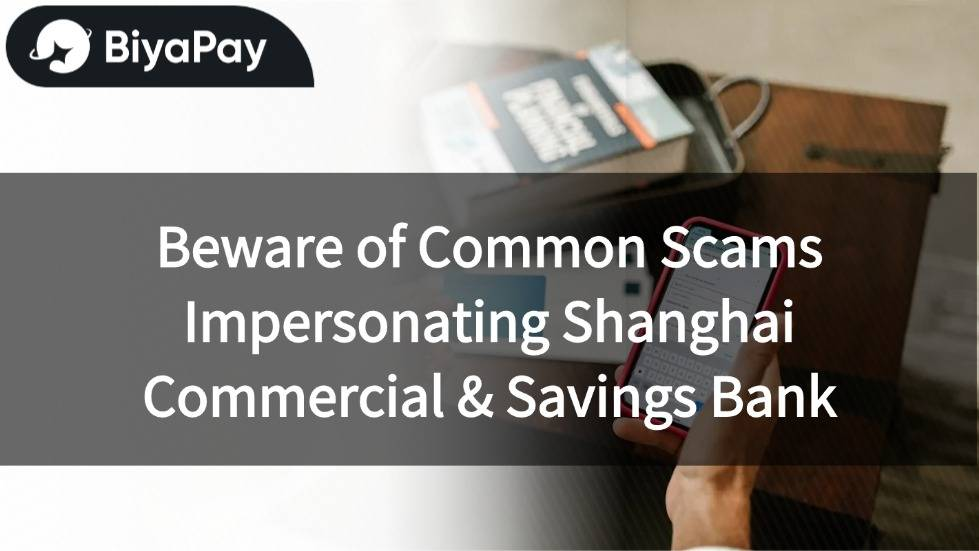- EasyCard
- Trade
- Help
- Announcement
- Academy
- SWIFT Code
- Iban Number
- Referral
- Customer Service
- Blog
- Creator
Beware of Common Scams Impersonating Shanghai Commercial & Savings Bank

Image Source: pexels
In daily life, you may encounter scams impersonating Shanghai Commercial & Savings Bank. Scammers often pose as bank staff, create fake websites or messages, and trick you into providing personal information or money. Can you distinguish genuine bank messages from fake ones?
You should know that financial institutions’ in-person interventions have successfully prevented over 24,000 scams, with a blocked amount reaching USD 15.5 billion (calculated at the latest exchange rate). Each year, approximately 30 million scam messages are blocked, showing that scam tactics are becoming increasingly diverse.
Raising awareness can help you protect your financial security.
Key Points
- Scammers often impersonate Shanghai Commercial & Savings Bank staff or create fake websites to trick you into providing personal information or money, so stay highly vigilant.
- When receiving suspicious calls or messages, proactively verify through official channels, and do not trust or respond directly to unfamiliar numbers.
- Banks will not request passwords or verification codes via email or text messages; delete such messages immediately and notify the bank.
- Protecting personal information and regularly checking account transaction records can help detect abnormalities early and safeguard your assets.
- Utilize Shanghai Commercial & Savings Bank’s official website, customer service hotline, and the 165 anti-fraud hotline to report suspicious situations promptly, effectively preventing scam losses.
Scam Tactics

Image Source: pexels
Impersonating Bank Staff
You may receive calls or instant messages from individuals claiming to be Shanghai Commercial & Savings Bank staff. Scammers may use the bank’s name, claiming your account has issues, needs an upgrade, or offers low-interest loan promotions. They may even fake toll-free numbers to make you believe it’s a legitimate bank call. If you inadvertently disclose personal information or one-time passwords, your funds could be stolen.
You should know that scammers use psychological tactics, such as the sunk cost effect and reciprocity principle, to lure you step-by-step into their trap. According to the U.S. Federal Trade Commission (FTC), scammers impersonate various identities, including bank staff, military personnel, or investment experts, with ever-evolving tactics.
Fake Websites and Social Media
When searching for Shanghai Commercial & Savings Bank or other Hong Kong banks, you may encounter fake official websites, social media accounts, or apps. Scammers use SEO and targeted ads to make fake websites rank high in search results. They may also flaunt wealth on social platforms to lure you into private groups, then guide you to click unfamiliar links or download apps.
- In 2023, Taiwan recorded over 2.85 million online scam cases, with fake websites and social media scams being one of the primary methods.
- Phishing websites, shopping scams, and romance scams together totaled 1.93 million cases.
- In March 2024, reported cases of fake investment and online shopping scams exceeded 5,000.
- In Q2 2024, Facebook removed over 40,000 investment scam ads.
If you trust these fake websites or groups, your personal information and funds are at risk.
Fake Emails and Text Messages
You may receive emails or text messages claiming to be from Shanghai Commercial & Savings Bank, asking you to click links, enter passwords, or provide verification codes. Remember, banks will not request sensitive information through these channels.
| Source Report | Specific Data | Description |
|---|---|---|
| ReasonLabs’ 2023 Cybersecurity Summer Trends Report | 43.6% of cyber threats are related to phishing, scam emails, or messages tricking users into providing private information | Phishing-related attacks account for a high proportion, indicating rising attack frequency |
| Comcast Annual Report | 90% of cyberattacks originate from phishing | Phishing is the primary attack vector, with high frequency |
| Hiscox Survey Report | 53% of businesses experienced at least one cyberattack in the past 12 months | Over half of businesses were attacked, with small businesses seeing increased attack frequency |
| Brooks Citation | Hackers use AI to automate phishing processes, expanding attack scale | Technological advancements amplify attack frequency and scale |
| Kaspersky data shows that phishing attacks in 2022 reached 5.5 billion, a 61% increase from the previous year. If you click unknown links, your account information can easily be leaked. |
Credit Card and Payment Scams
When shopping online or using digital payments, be cautious of credit card and payment scams. Scammers may pose as seller customer service, tricking you into clicking phishing links or entering card details. During the pandemic, global payment scam cases increased by 35%, with non-face-to-face transaction scam rates in the U.S. reaching 3.1% and credit card scam rates in the EU increasing by 13%.
| Metric | Change Rate/Data | Time/Region |
|---|---|---|
| Global payment scam case increase rate | Increased by 35% | During the pandemic |
| U.S. non-face-to-face transaction scam rate | Reached 3.1% | During the pandemic |
| EU credit card scam rate | Increased by 13% | During the pandemic |
| Proportion of scams related to digital transactions | Approximately 80% | During the pandemic |
| U.S. unemployment benefit identity theft cases | Surged from less than 20 to nearly 750 | October 2019 to 2020 |
| If you don’t verify website authenticity or casually enter information, your credit card details can easily be stolen. |
Money Laundering Accounts
You may encounter scammers asking you to lend your account or assist with transfers, claiming high returns. These are money laundering account scams. Criminal groups use low-capital companies to open accounts for large-scale fund transfers.
| Item | Specific Figures | Description |
|---|---|---|
| Suspected money laundering transaction patterns | 15 types | Banks use transaction amounts above a certain threshold as a criterion, modeling risk controls, and freezing suspicious accounts |
| Anti-fraud cases (2017-2022) | 17,119 cases | In-person interventions and measures effectively prevented fraud cases |
| Anti-fraud amount (2017-2022) | USD 7.918 billion | The massive amount involved shows the significant impact of scams |
| Fraud losses in 2022 | Approximately USD 7 billion | Annual fraud losses reflect the severity of scams |
| Capital for shell companies | Approximately USD 100,000 | Criminal groups use low capital to establish companies and open accounts for large transactions |
| Corporate account transfer limits | Millions of USD | Corporate accounts have much higher limits than personal accounts, facilitating money laundering |
| Daily suspicious transaction screenings by Chunghwa Post | 300 to 400 cases | Indicates frequent and large-scale suspicious transactions, with active postal interventions |
| Proportion of flagged accounts | Approximately 0.045% | Although slightly rising, the proportion remains low, reflecting effective controls |
| If you lend your account or assist with transfers, you may become an accomplice to money laundering and even violate the law. |
Identification Methods

Image Source: pexels
Verify Calls and Messages
When receiving calls claiming to be from bank staff, you should proactively verify their identity. Note the caller’s number, then use another phone to contact the bank’s official customer service or check the bank’s official website to confirm if the notification is legitimate. Do not directly call back the displayed number, as scammers may fake caller ID.
You can refer to the following table to understand the success rate of verifying calls at different stages:
| Stage | Success Rate Calculation | Specific Data Example | Success Rate |
|---|---|---|---|
| Cold calling potential clients | Transactions ÷ Potential clients | Added 30 potential clients in a week, closed 3 deals | 10% |
| Conversion rate after scheduling meetings | Transactions ÷ Meetings | Closed 2 deals out of 5 meetings | 40% |
| Call duration and meeting scheduling | Longer calls increase meeting scheduling chances | No specific figures, but an effectiveness indicator | N/A |
You can see that proactive verification and longer call durations help improve the success rate of identifying authenticity. Many banks and businesses use CRM systems to record call verification processes and optimize communication strategies through A/B testing. By continuously analyzing this data, you can enhance your ability to identify scams.
Tip: When receiving unfamiliar calls, stay calm and don’t rush to respond. Contact the bank’s official customer service or visit a branch in person to ensure the information is accurate.
Suspicious Characteristics
You should learn to observe the characteristics of suspicious messages to significantly reduce the risk of being scammed. Here are common suspicious characteristics:
- The other party urgently requests personal information, passwords, or one-time verification codes.
- The message contains words like “urgent,” “limited time,” or “account abnormality” to create pressure.
- Offers overly attractive deals, such as ultra-low interest loans or high-return investments.
- Asks you to click unknown links or download unfamiliar apps.
- Claims to be authorized by the government, Hong Kong banks, or well-known companies.
- Contains grammatical errors, unnatural wording, or obvious translation traces.
If you notice any of these characteristics, you should immediately raise your guard. Verify the source of the message or contact Shanghai Commercial & Savings Bank’s official customer service. Do not trust someone just because they claim to be bank staff. Remember, banks will not proactively ask for your password or verification code.
Note: If you suspect a scam, stop all actions immediately and verify through official channels. You can call the 165 anti-fraud hotline or contact the bank’s official customer service to protect your financial security.
Prevention Tips
Protect Personal Information
You must always protect your personal information. Do not casually disclose your ID number, bank account, password, or one-time password. Many scam cases occur due to personal information leaks. According to statistics, the risk of personal information leaks is continuously rising:
- In 2021, Taiwan recorded approximately 24,000 scam cases, with over 44,000 victims, a 10-year high.
- In the first nine months of 2022, scam cases reached 21,000, expected to hit a new high for the year.
- In February 2023, the iRent data breach exposed approximately 140,000 personal records, highlighting severe challenges in data protection.
Regularly check if your personal information has been misused, and never provide details to unknown calls or messages.
Official Channels for Contact
You should only contact the bank through Shanghai Commercial & Savings Bank’s official website, customer service hotline, or the phone number on the back of your card. Do not trust contact details from unknown websites, social media accounts, or unfamiliar messages. Experts recommend using official channels to effectively prevent phishing attacks and fake customer service:
- Use only official websites and apps to avoid phishing websites.
- Official customer service will not privately message you or request passwords or verification codes.
- Security tools can automatically block suspicious websites to protect you.
- Official channels provide the latest anti-fraud information to help you identify scam tactics.
- Some banks issue real-time warnings about suspicious websites, further protecting your funds.
Verify Immediately if Suspicious
If you encounter suspicious messages or calls, stop all actions immediately. Hang up the call and verify through official channels. You can also call the 165 anti-fraud hotline or contact Shanghai Commercial & Savings Bank’s customer service directly. Do not trust someone just because they claim to be bank staff. Proactive verification can significantly reduce the risk of being scammed.
Tip: When faced with urgent requests or high-return offers, stay calm and think carefully before responding.
Regularly Check Accounts
Regularly log into online or mobile banking to check your account and transaction records. If you notice any unfamiliar transactions, notify the bank immediately. Set up transaction notifications to stay informed about account activities in real time. Regularly checking your account helps detect abnormalities early and protects your financial security.
Shanghai Commercial & Savings Bank Official Resources
Official Website and Accounts
Ensure you only use Shanghai Commercial & Savings Bank’s official website and social media accounts to avoid fake websites or unsafe app downloads. Refer to the table below for quick access to official resources:
| Service Item | Official Information |
|---|---|
| Official Website | https://www.scsb.com.tw |
| Official Facebook | https://www.facebook.com/SCSBtw |
| Official LINE Account | @scsb |
| Official App Download | Search for “Shanghai Commercial & Savings Bank” only on App Store or Google Play |
Do not click on search engine ad links or trust websites shared by strangers. Directly enter the URL or obtain download links from official announcements to significantly reduce scam risks.
Tip: Bookmark the official website for easy future access and login.
Customer Service Hotline and Reporting
If you encounter suspicious messages or suspect a scam, immediately verify through the official customer service hotline. Shanghai Commercial & Savings Bank offers 24-hour customer service to address your concerns. You can also call the 165 anti-fraud hotline to report suspicious situations.
Below are commonly used official contact methods:
- Customer Service Hotline: 0800-003-111 (toll-free in Taiwan)
- Overseas Calls: +886-2-2552-3111
- 165 Anti-Fraud Hotline
Proactively reporting and verifying can effectively reduce scam losses. According to the latest data:
- Since May 2023, telecom operators have blocked over 1 million scam calls.
- Chunghwa Telecom used AI to block over 41 million malicious text messages.
- Taiwan Mobile identified over 1,500 fake websites in just over a month, enhancing scam detection capabilities.
- Far EasTone’s AI detection system reduced scam calls by nearly 90% and text interception rates exceeded 90%.
- LINE proactively handled high-risk scam accounts, processing over 900 accounts by the end of May this year.
By utilizing official resources and reporting promptly, you can significantly enhance your anti-fraud security.
By staying highly vigilant and proactively verifying calls and messages, you can effectively reduce scam risks. According to statistics, scam cases and financial losses are rising yearly, but verifying during the “golden anti-fraud period” can minimize losses.
| Year | Number of Scam Cases | Financial Losses |
|---|---|---|
| 2017 | 22,689 cases | Approximately USD 4 billion |
| 2023 | Over 30,000 cases | USD 8.9 billion |
| First 5 months of 2024 | 93,379 cases | USD 62.9 billion |
| Share anti-fraud information with family and friends to raise collective awareness. When encountering suspicious situations, stay calm and seek official assistance immediately. |
FAQ
How do you distinguish genuine from fake Shanghai Commercial & Savings Bank websites?
You should directly enter the official URL: https://www.scsb.com.tw. Do not click on search engine ads or unfamiliar links. Check if the URL is correct to avoid phishing websites.
Will the bank ask for passwords via text or email?
The bank will not request passwords or one-time verification codes via text or email. If you receive such messages, delete them immediately and notify the bank.
What should you do if you receive a suspected scam call?
You should hang up immediately and verify through the official customer service hotline. Call 0800-003-111 or the 165 anti-fraud hotline to ensure your safety.
How do you protect your personal information?
Do not casually disclose your ID number, bank account, or password. Regularly check account records and notify the bank immediately if you notice abnormalities.
What should you do if you suspect you’ve been scammed?
Immediately contact Shanghai Commercial & Savings Bank’s customer service and report to the police. Keep relevant messages or evidence to assist with the investigation.
In 2025, scams impersonating Shanghai Commercial & Savings Bank are rampant, with high fund management costs and concerns over platform security making investors wary of cross-market trading. BiyaPay offers a secure, user-friendly solution to safeguard against fraud. No need for additional overseas accounts—BiyaPay enables trading in both U.S. and Hong Kong stocks with a single account. Start now at BiyaPay!
BiyaPay supports real-time conversions across multiple fiat and digital currencies with transparent rate queries, ensuring clear cost management. With remittance fees as low as 0.5%, it minimizes expenses. Regulated by international financial authorities, BiyaPay provides a robust platform, letting you focus on your investment strategy with confidence. Visit BiyaPay today to secure your financial future!
*This article is provided for general information purposes and does not constitute legal, tax or other professional advice from BiyaPay or its subsidiaries and its affiliates, and it is not intended as a substitute for obtaining advice from a financial advisor or any other professional.
We make no representations, warranties or warranties, express or implied, as to the accuracy, completeness or timeliness of the contents of this publication.




Contact Us
Company and Team
BiyaPay Products
Customer Services
is a broker-dealer registered with the U.S. Securities and Exchange Commission (SEC) (No.: 802-127417), member of the Financial Industry Regulatory Authority (FINRA) (CRD: 325027), member of the Securities Investor Protection Corporation (SIPC), and regulated by FINRA and SEC.
registered with the US Financial Crimes Enforcement Network (FinCEN), as a Money Services Business (MSB), registration number: 31000218637349, and regulated by FinCEN.
registered as Financial Service Provider (FSP number: FSP1007221) in New Zealand, and is a member of the Financial Dispute Resolution Scheme, a New Zealand independent dispute resolution service provider.




















